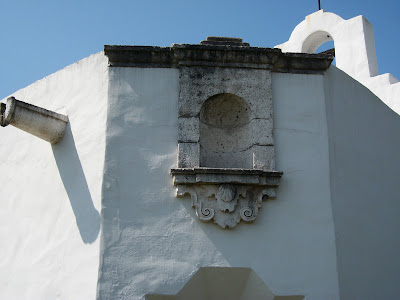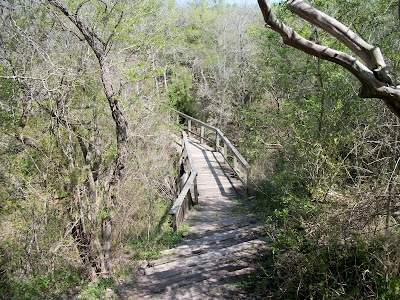"Remember the Alamo" is actually not the complete rallying cry for the "Texians" at San Jacinto; they also had the the massacre at Goliad fresh in their minds as they stormed Santa Anna's camp. Apparently the Mexican army had taken captive Colonel Fannin and his forces in the Battle of Coleto, and then Santa Anna had had them all executed. Here is a monument to them just outside of town:
Just as with the Alamo in San Antonio, the centrality of the Spanish sites in Goliad to the Texas Revolution has been a factor in motivating the government and private foundations to take an interest in their preservation, which is something to be grateful for.
Goliad itself is a small and pleasant town with a touristy central square where you can eat at the Blue Quail Deli between sightseeing. There are two main sites of interest there: Misión Nuestra Señora del Espíritu Santo de Zúñiga and the presidio that protected it, Presidio La Bahía. Both were moved there in 1747 from their previous locations, first at Matagorda Bay, then later in the area of what is now nearby Victoria. The mission is now part of a state park that also includes nature trails and campgrounds. It was abandoned around 1830, disintegrated into ruins, and was eventually restored and even partially reconstructed by the Civilian Conservation Corps. The result is exquisitely photogenic:
Some of these buildings are still in ruins, but several have been converted into museum space. I was surprised that the chapel itself, although state property, has been restored as a functioning church. It is easy to see how the neophytes would have felt reverence in this place:
And I'm sure that the little memento moris right outside the chapel just added to the sense of awe:
I, however, felt the most awe-inspired by a small corner of the granary that is left unrestored to show how it was two hundred years ago:
The priests' quarters also have at least the appearance of originality, although I'm sure that there has been considerable renovation:
This iron work, for example, cannot possible be original, but it is quite lovely:
As I mentioned before, the mission is part of a state park that is actually quite appealing in its own right. There is a well-maintained nature trail that can be traversed in about twenty minutes:
This stone structure is on that trail. I meant to ask the rangers what it was, but I forgot to. It appears to be a chimney of some sort, but I don't know if it's from the Spanish era or just something build by the CCC or park service.














